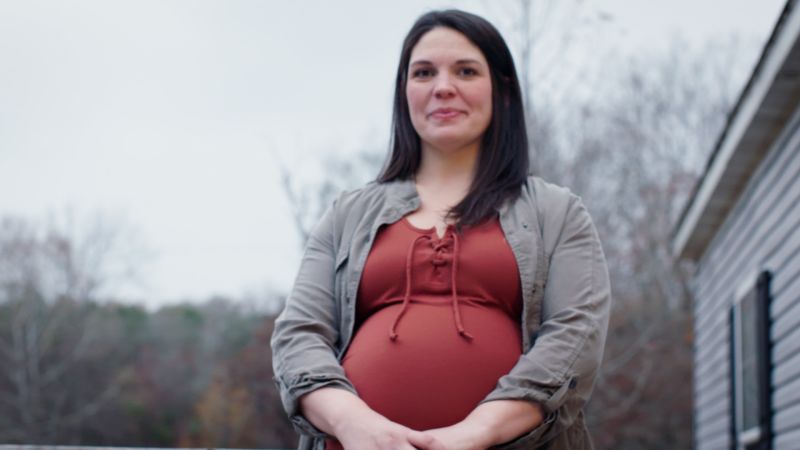An Alabama woman with the rare condition of two uteruses, and who became pregnant in each uterus earlier this year, gave birth to twins last week a day apart.
After a combined 20 hours of labor, Kelsey Hatcher gave birth to her third and fourth children, a set of rare twins, on Tuesday and Wednesday of last week, according to a news release from the University of Alabama at Birmingham Hospital.
Hatcher was induced at 39 weeks and throughout labor had twice the monitoring and twice the charting and was assigned two labor and delivery nurses, the release says.
Baby A, named Roxi, was born vaginally at 7:45 p.m. on December 19.
“There was a cheer from everyone in the room when the first baby was delivered, but there was another baby left,” Dr. Shweta Patel, Hatcher’s obstetrician, said in the news release. “Kelsey was essentially laboring in the left uterus while simultaneously undergoing the postpartum process in the right.”
While having contractions with Baby B, Hatcher was already breastfeeding Baby A, Patel noted.
And nearly 10 hours later, Baby B, named Rebel, was delivered by Cesarean section at 6:10 a.m. on December 20.
“After such a long and crazy journey, it meant the world to see both of my girls together for the first time,” Hatcher said.
According to doctors, the girls are technically twins despite having two different birthdays and being in two wombs during pregnancy.
“I think it is safe to call the girls fraternal twins,” said Richard O. Davis, professor in the UAB Division of Maternal-Fetal Medicine and a doctor who co-managed Hatcher’s pregnancy.
“At the end of the day, it was two babies in one belly at the same time. They just had different apartments,” Davis added.
Case studies estimate the chances of pregnancy like this – a woman with two uteruses carrying a baby in each one at the same time – at around 1 in 2 billion in the general population, though it’s impossible to know for sure with something this infrequent.
“Never in our wildest dreams could we have planned a pregnancy and birth like this, but bringing our two healthy baby girls into this world safely was always the goal, and UAB helped us accomplish that,” Hatcher said, “It seems appropriate that they had two birthdays, though. They both had their own ‘houses,’ and now both have their own unique birth stories.”
A surprising discovery
At her first ultrasound appointment, about eight weeks into pregnancy, things took an unexpected turn. The ultrasound technician quickly found the baby and told Hatcher everything looked perfect. The baby was healthy.
Then Hatcher remembered to tell the tech that her anatomy was a little different.
“So if you’re scanning and maybe catch a glimpse of it or something, don’t think it’s just something random or there’s something wrong. There is a totally separate uterus there,” said Hatcher.
Hatcher said the ultrasound tech thanked her for letting her know and said she would just take a quick peek at the second uterus to make sure everything looked good.
“And as soon as she moved the ultrasound wand over to the other side of my belly, I said, ‘Oh, my gosh! There’s another one.’”
Hatcher didn’t even need to be told there was another baby. She could see it herself.
“The nurse practitioner that I met with that day, she was just blown away. She said, ‘I’m not even sure what the statistics of this are,’ ” Hatcher recalled.
Hatcher says she got lucky, in a way, because some women with uterine didelphys have only one working uterus; the other can’t support a pregnancy. But her medical records show that she has carried babies in both of hers, just never before at the same time.
The unusual anatomy also had a visual difference. In certain positions, she had not just one baby bump but two, she said.
When she lied in her recliner in the evening, “the girls will separate, almost, and you can see vividly the two separate wombs, because there’s a big gap in my stomach where they fall to one side or the other.”
The long, long odds
The odds are mind-boggling. About 3.6 million babies were born in the US last year, but only about 114,000 of those births were twins, according to the US Centers for Disease Control and Prevention.
In other words, about three sets of twins are born for every 200 live births, according to the CDC, and two of those sets are likely to be fraternal, which means they come from two separate fertilized eggs.
Hatcher’s condition is rare, too: About 1 in 2,000 women is born with uterine didelphys.
In order for her to become pregnant in both of her uteruses at the same time, two eggs had to be fertilized, one in each uterus.
Like most women, Hatcher has two ovaries, the glands that store and release eggs. Each of her ovaries feeds a single uterus. Typically, ovaries take turns releasing eggs, sending one into the uterus each cycle for a chance at being fertilized. Occasionally, however, an ovary may release more than one egg during each cycle, a phenomenon called hyperovulation.
Hyperovulation hasn’t been extensively researched, but one 2006 study of 500 women found that about 1 in 5 of them was able to hyperovulate. But even for those women, it doesn’t happen each cycle. When it does, sometimes a single ovary may release two eggs. And even more infrequently, both ovaries will release a single egg at the same time, which is what happened in Hatcher’s case.
Hatcher was about seven times more likely to win a Powerball jackpot and about 131,000 times more likely to get hit by lightning at some point in her life.





